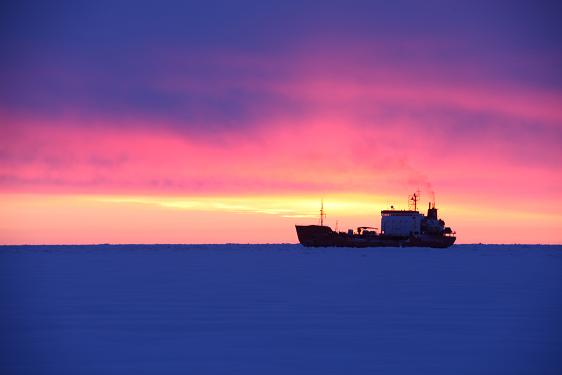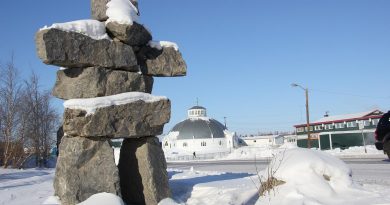The icebreaker that could: Russian tanker brings fuel to remote Alaska
 The isolation of Nome, Alaska has garnered the small city a certain degree of infamy. No roads lead to the city of 3,500 from the rest of the state. The only way in is by plane, ship, or dogsled, as was done in 1925 to bring emergency medical supplies to residents. Now, as mentioned before, the city is short of oil and diesel due to the failure of the Delta Marine barge to arrive as scheduled in mid-November.
The isolation of Nome, Alaska has garnered the small city a certain degree of infamy. No roads lead to the city of 3,500 from the rest of the state. The only way in is by plane, ship, or dogsled, as was done in 1925 to bring emergency medical supplies to residents. Now, as mentioned before, the city is short of oil and diesel due to the failure of the Delta Marine barge to arrive as scheduled in mid-November.
A massive storm stopped the ship from coming to port and ended up freezing the waters around the city. Diesel, used to heat homes, could run out by March, according to the New York Times. However, Sandra Medearis of the Nome Nugget reports, “Contrary to continued erroneous reports and rumors, the town’s two petroleum products distributors have enough heating fuel on hand for the winter, according to their managers.”
Either way, a regular ship cannot come to Nome until June or July, and if the Russian ship Renda makes it to Nome, the New York Times says it would be “making the first maritime fuel delivery through sea ice in Alaska history.”
The icebreaker-that-could, USCGC Healy, is carving out a path in the Bering Sea for the Renda, which is carrying 1,062,000 gallons of diesel and 300,000-400,000 gallons of gasoline. The Russian-flagged double-hulled, ice-class tanker picked up the gasoline in Dutch Harbor, Alaska, which necessitated a special waiver of the Merchant Marine Act of 1920, also known as the Jones Act. Passed in 1920 to protect the maritime industry, the act does not allow the transportation of goods between two points in the U.S. in a foreign-flagged ship.
Special challenges
The New York Times article offers a detailed overview and helpful map of the situation and the difficulties the icebreaker and the ship are facing. First, the Healy is not a heavy-duty icebreaker, so it has to slowly chug through all three hundred miles of the ice to the port of Nome. Right now, it is going about five to six miles a day, and some of the ice is at least a foot thick. Reconnaissance flights showed that some of the first-year ice the ships will soon be encountering is up to three feet thick. Rear Admiral Thomas Ostebo, commander of the Coast Guard’s Seventeeth District, said that the transit could perhaps have been facilitated by the use of a heavy-duty icebreaker, of which the U.S. has none that are operational.
If and when Healy arrives, it will not be able to come more than half a mile from shore. From there, the Renda will continue as close as it can to shore, but will probably not be able to reach the fuel headers due to its draught. On the Coast Guard Compass Blog, Lieutenant Connie Braesch reports, “From this point, there are a number of options being explored to get the fuel the remainder of the way including using a fuel hose from the barge to shore.”
Weather a factor
First, though, the Healy and the Renda have to make it to Nome. As of Monday, the Renda was 150 miles away. Weather conditions are making it very difficult for the ships to sail, too. With Nome currently sitting at -15 degrees Fahrenheit, it’s probably colder offshore. The temperature in Nome has not gone above 0 degrees Fahrenheit since December 23. More snow is on the way, too. As the Healy cuts through the frozen sea, the tides are such that much of the ice closes in behind the ship, complicating the Renda’s journey. Furthermore, the Healy cannot travel at its highest potential speed, which Ostebo stated could be close to 10 knots through first-year ice. This is because Healy has to stay close enough to the slower-moving Renda to break ice for her. In the thicker ice that Healy may soon be encountering, it can travel at three knots.
Despite the challenging conditions, spirits seem to be high. Captain Peter Garay is an Alaska Marine pilot stationed onboard Renda. He blogged for the Alaska Dispatch.
“One hundred miles to go! We just crossed the mark. Renda and Healy have finally got it together. They seem to be progressing fairly well. [The] learning and understanding curves have been fabulous.
It’s probably the most awesome voyage I’ve had in my 40 years of going to sea.
Optimism is running high, everybody is working well together and Mother Nature is cooperating for a change. The first 100 miles we had to literally crawl-claw ourselves through.
Hope to see you in Nome. All the best to you, – Capt. Pete.”
Additional Sources
- The Nome Nugget has a good story on the race to bring oil to Nome, including background on what it took to get the waiver approved.
- More high-resolution photos taken by Coast Guard officers are available here.




